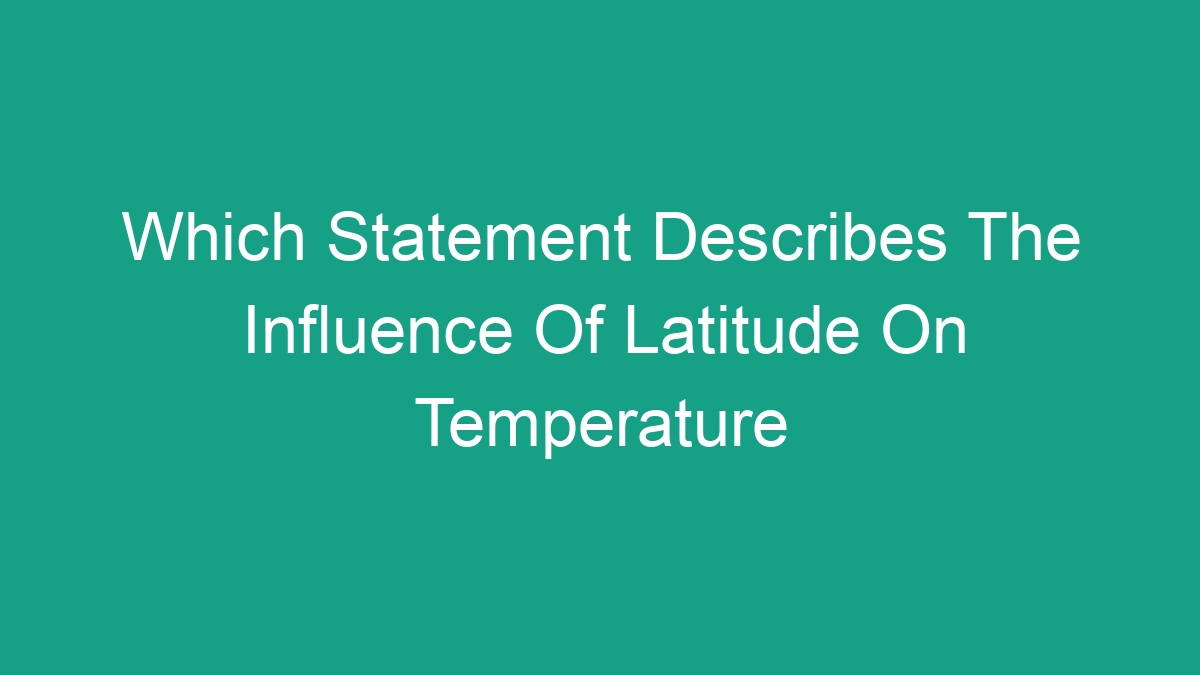
Understanding Latitude and its Influence on Temperature
Latitude is the angular distance of a location north or south of the earth’s equator, measured in degrees. It plays a significant role in determining the climate and temperature of a particular region. The influence of latitude on temperature is a key factor in understanding the variability in weather patterns across the globe.
The Relationship Between Latitude and Temperature
The general rule of thumb is that the closer a location is to the equator, the warmer its climate. This is due to the curvature of the earth and the angle at which the sun’s rays strike the earth’s surface. Near the equator, the sun’s rays are more direct, resulting in higher temperatures. However, as you move farther away from the equator, the angle at which the sun’s rays hit the earth becomes more oblique, leading to cooler temperatures.
Understanding the Tropics, Temperate Zones, and Polar Regions
Within the framework of latitude, the earth can be divided into three main climate zones: the tropics, the temperate zones, and the polar regions.
The tropics, which lie between the Tropic of Cancer (23.5°N) and the Tropic of Capricorn (23.5°S), are characterized by consistently warm temperatures throughout the year. This is due to their proximity to the equator, where the sun’s rays are most direct. The tropical climate is typically hot and humid, with very little variation in temperature.
The temperate zones, which lie between the tropics and the polar regions, experience more variation in temperature throughout the year. The temperate zones include the regions between the Tropic of Cancer and the Arctic Circle in the Northern Hemisphere, and the Tropic of Capricorn and the Antarctic Circle in the Southern Hemisphere. These regions experience distinct seasons, with warmer summers and colder winters.
The polar regions, which lie near the North and South Poles, are characterized by extremely cold temperatures due to their distance from the equator. These regions receive very little direct sunlight throughout the year, leading to prolonged periods of darkness and cold temperatures.
Factors Affecting Temperature Variation
While latitude is a significant factor in determining temperature, there are other factors that can influence temperature variation within a specific region. These factors include altitude, proximity to bodies of water, ocean currents, and prevailing wind patterns.
Altitude plays a role in temperature variation, with higher elevations generally experiencing cooler temperatures. This is due to the decrease in air pressure and the subsequent drop in temperature as altitude increases.
Proximity to bodies of water can also have a moderating effect on temperature. Coastal areas tend to have milder climates compared to inland regions, as the ocean acts as a heat sink, absorbing and releasing heat more slowly than the land.
Ocean currents can also impact temperature, with warm ocean currents bringing higher temperatures to coastal areas, while cold ocean currents can lead to cooler temperatures.
Prevailing wind patterns can transport air masses from one region to another, affecting temperature and weather patterns. For example, winds blowing from the ocean can bring cooler temperatures to coastal areas, while winds blowing from inland regions can bring warmer temperatures.
Climate Change and the Influence of Latitude
Climate change is having a significant impact on global temperature patterns, with widespread implications for regions across the globe. As the earth’s climate continues to warm, the influence of latitude on temperature may become even more pronounced.
Rising global temperatures are having a particularly significant impact on polar regions, leading to accelerated melting of polar ice caps and changes in the distribution of wildlife. The warming of polar regions can also have cascading effects on global weather patterns, with potential implications for regions across the globe.
Increased frequency and intensity of extreme weather events such as heatwaves, hurricanes, and droughts are also being linked to climate change. These events can have a profound impact on ecosystems, agriculture, and human populations, highlighting the interconnected nature of the earth’s climate systems.
Conclusion
In conclusion, the influence of latitude on temperature is a fundamental concept in understanding the global distribution of climate and weather patterns. The relationship between latitude and temperature is a key factor in determining the climate of a particular region, with implications for ecosystems, agriculture, and human populations. As the earth’s climate continues to change, the influence of latitude on temperature may become even more pronounced, with far-reaching implications for the planet as a whole. Understanding the complexities of this relationship is crucial for addressing the challenges of climate change and developing strategies for building a more sustainable future.



